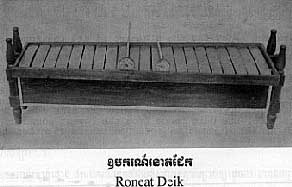| History
and background of Court Dance
Dance Costumes & Dance
Characters
Royal Dance Spectacles
Classical Court Dance Music
Masked Theatre (Lakhon Khol)
Shadow Theatre (Nang Sbek)
Traditional Cambodian Music Discography
|
|

Roneat is a generic term in Khmer
referring to xylophones and metallophones, with bars made from bamboo, hardwood or metal.
The word roneat comes from the Khmer word roneap meaning "bamboo
strips". Roneats have bars that are suspended with cords over both
boat-shaped or trough sound boxes. The xylophone in Thai and Laotian is called ranat,
while in Burmese it's called pa'tala and in Khmer roneat.
Khmer roneats have bamboo or hardwood
bars strung together along two cords running through holes in each bar and are suspended
on two hooks on the upper ends of the sound box. The roneat maker takes
care to ensure that the bars are spaced so evenly therefore they can vibrate freely.
|
Roneat ek is a
combination of two Khmer words roneat meaning "xylophone" and ek,
"leader", "first one", therefore meaning first xylophone or leading
xylophone. Roneat ek is also known as roneat rut "running
xylophone". Roneat ek has 21 slabs of hardwood or bamboo bars which are
29-39 cm long and is about 7 centimetres in width as well as being 1 to 1.5 centimetres
thick. The thick bars produce lower pitches while thinner bars produce higher
pitches.

Roneat ek
Roneat ek's resonator or sound box is about 115 centimetres long and
about 56 centimetres high, that sits on a raised square base which acts as a foot and is
14 centimetres high. Sometimes roneat ek is elaborately carved with Khmer motifs
and designs, making it a very beautiful musical instrument to admire as well as
play. The roneat ek is played with two long beaters that are 40 centimetres
long, with soft disks that are used for indoor functions that are about 4 centimetres in
diametre and 3 centimetres thick. While hard disks are used for outdoor functions
that measure 3.3 centimetres in diametre and 2 centimetres thick.
|
| Roneat thung is better called
roneat thom "large xylophone" because it's resonator and bars are longer
and larger than those of roneat ek, the pitch range is lower. Roneat thung
has a rectangular trough like resonator that measures about 125 centimetres long,
supported by four small short legs. The ends of both roneat ek and roneat
dek are flat and straight, however those of roneat thung are slightly curved
outwards. Roneat thung has 16 bars, while others might have 17 bars made from
hardwood or bamboo.

Roneat thom or Roneat thung
The longest bard measures about 47 centimetres long at the lower
end of the resonator and 38 centimetres long at the upper end of the resonator. Each
bar is about 6 centimetres in width and about 2 centimetres thick.Softer beaters are used to play roneat thung, whether it's
outdoor or indoor. The handle of the beaters are about the same length as those of
roneat ek, however the disks are larger and thicker. Each disk measures about 4
centimetres in diametre and about 3.5 centmetres thick.
|
| Roneat dek is a
high-pitched metallophone, with 21 bronze bars but aren't strung on cords because, of
their weight. Instead the bars are laid in stepwise order on pads over a rectangular
trough like resonator that measures about 1 metre long, and is supported by four small
short legs. In contrast roneak dek resembles roneak ek in shape
and size. But roneak dek is tuned differently by scraping or filing away the
parts of the metal. Roneat dek is played using two beaters that are
similar to roneat ek but with disks made from wood or buffalo hide. Roneat ek is
played in the same style as roneak ek.

|
|